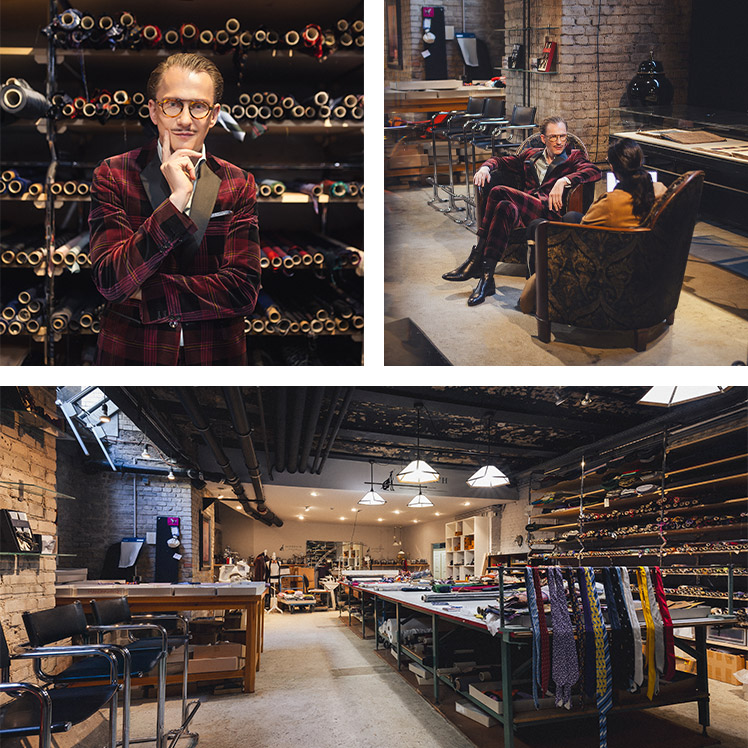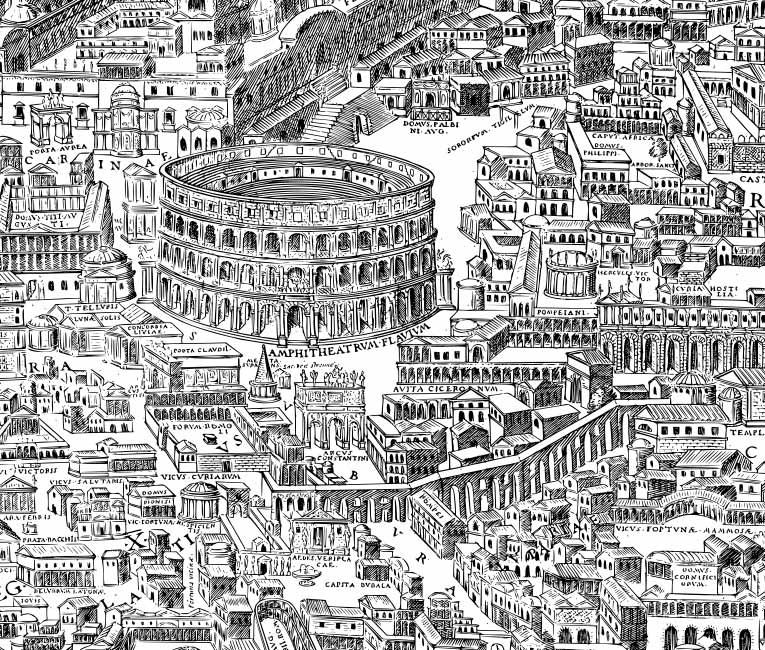As CEO of the traditional Auerbach manufactory in Berlin’s Hackesche Höfe, he has created a space that unites craftsmanship, elegance, and modernity. At the same time, as an eloquent presenter, columnist, and TV personality, he is a prominent figure in German media.
Yet behind his sophisticated demeanor and charismatic presence lies a sharp observer of the fashion industry who is unafraid to voice critical opinions. In a candid conversation with AVIAIR editor-in-chief Sabine Kühlwetter Meiers, Jan-Henrik Scheper-Stuke revealed himself as far more than an ambassador of impeccable style: a reflective, witty, and charismatic individual whose passion for aesthetics goes far beyond the surface.
In 2023, Jan-Henrik Scheper-Stuke, who appeared as a fashion expert on the Netflix reality series "Queer Eye Germany," was honored with the Grimme Award.
AVIAIR: Mr. Scheper-Stuke, style seems to be a central theme in your life. Do you think style is innate, or can it be learned?
JAN-HENRIK SCHEPER-STUKE: That’s a fascinating question! I believe style is a combination of talent and experience. Some people have a natural flair for aesthetics, while others develop it through observation and learning. For me, it was likely a mix of both. My time at Schloss Louisenlund boarding school played a significant role. There, clothing wasn’t just functional but also a way of expressing respect and appreciation. My father was another major influence – a man with an almost instinctive sense of elegance that rubbed off on me. He never explicitly told me how to dress, but his demeanor silently guided me.
It sounds like your family had a significant impact on your sense of style.
Absolutely. If I showed you a photo of my father, it would be immediately clear where my sense of style comes from. He was a man who knew how to present himself – whether in a business suit or a work apron. My mother, on the other hand, had an effortless elegance that can’t be taught. She showed me that style isn’t just external; it’s an attitude. Style means being self-aware without coming across as arrogant.
So, a combination of role models and intuition?
Exactly. Style isn’t something you can force. If someone has no interest in it, they won’t connect with it. It’s about cultivating curiosity, discovering colors and textures, and experimenting. For instance, moss green and apple green rarely work well together – but paired with a deep navy blue, they create a harmonious look. You learn these nuances by being willing to pay attention.
You have a particular fondness for accessories, especially bow ties …
A bow tie is more than just an accessory – it’s a statement. It signals individuality, personality, and a certain joy in style. I still vividly remember my first bow tie: it started as an experiment and quickly became a passion. Today, I wear them with conviction and take pride in the fact that our manufactory produces bow ties that are true one-of-a-kinds.
At your Auerbach manufactory, the attention to detail is remarkable. It feels like stepping back into the Golden Twenties.
That’s exactly our goal. We want our customers to feel like they’re traveling back in time to an era where elegance and craftsmanship were held in high regard. The atmosphere of the Hackesche Höfe, the Art Deco interiors, and our glass-walled workshop all contribute to this sense of magic. We want people to see the heart and soul that goes into each product. During our “My Tie” live events, customers can even watch a bow tie or tie being made in real time.
Watching something being made live must be a unique experience. What makes a bespoke tie so special?
A bespoke tie is an expression of individuality. It’s tailored precisely to the wearer’s measurements, ensuring the length, width, and material align perfectly. A tie that doesn’t fit can ruin an entire outfit. Our customers can follow the entire process – from cutting the fabric to the final stitch. This experience creates a connection between the customer and the product, something rare in today’s fastpaced world.

VISIONS AND GOALS: THE FUTURE OF AUERBACH
You’re a visionary. Share with us your vision for Auerbach’s future.
My goal is to establish Auerbach as a brand synonymous with timeless elegance and uncompromising quality. Over the next five years, we plan to open ten additional locations, starting in Germany. What’s crucial to me is maintaining the right balance. Growth must not come at the expense of our identity. Auerbach is not just a business – it’s a stage where tradition and modernity meet.
That’s an ambitious plan.
Are there plans for shops in other European cities? Absolutely. Vienna is an obvious candidate, but cities like Paris or Zurich are equally enticing. The key is finding partners who share our values.
A DANDY BETWEEN THE STAGE AND EVERYDAY LIFE
You’re often called the “Reigning Dandy of Berlin.” How much of that is image, and how much is authentic?
It depends on the day. There are days when I consciously play the part: the perfect bow tie, a flawless suit, everything meticulously coordinated. And then there are days when I wear sweatpants and my “Lazy Willi” cap – a look that makes my staff chuckle. But no matter what I wear, I always remain myself. This dandy persona is part of me, but it’s not the whole picture.
You have a knack for making classic fashion feel modern. That effortless way you present yourself …
I constantly question myself and my customers. Fashion must never stagnate; it has to evolve. A classic tie or bow tie can tell an entirely new story through the right cut, modern materials, or unconventional combinations. That’s what fascinates me about my work – the constant pursuit of the perfect balance between tradition and innovation.
You have so much experience and a keen eye for quality. If you could collaborate with any designer, past or present, who would it be?
Without hesitation: Karl Lagerfeld. He was a visionary who created fashion at the highest level, always with an unmistakable style.
And today? Is there someone who impresses you in a similar way?
Dries Van Noten. His work embodies everything I value in fashion: exquisite fabrics, great tailoring, an exceptional sense of color. His designs are always wearable, always special. And always innovative – but not in the way brands like Balenciaga or OffWhite churn out what I’d call the new generation of "trash fashion."
That sounds like a critique of the industry.
Absolutely. When a plastic bracelet sells for thousands of euros, I wonder if it’s still fashion or just pure provocation. I even think some designers deliberately provoke and say, “Let’s see who buys this.” That kind of "fashion" holds no value for me – it’s arbitrary.

Earlier, you spoke about the importance of a precisely coordinated outfit and the pursuit of perfection in your work.
Yes, but authenticity is the foundation of everything. I can be perfect in my craft, but if I come across as inauthentic, everything loses its value. That also means embracing my flaws. Perfection is a goal, but authenticity is the path.
Isn’t it difficult to balance the two? Perfection often requires discipline, while authenticity is softer and more honest.
That’s true, and it’s the main challenge. I’m only perfect as part of a team, through the support of people who complement me. But I believe perfection should never come at the cost of authenticity. If I lose my authenticity in the pursuit of perfection, the price is too high.
At Auerbach, sustainability is a key focus. But it seems like more than just a trend for you – it feels like a genuine conviction.
Sustainability isn’t a marketing gimmick for us. It’s part of our philosophy. For instance, we offer a “tie hospital” where old ties can be restored or repurposed, perhaps into bow ties. Many customers appreciate this because they don’t want to throw away their favorite pieces.
That sounds like genuine appreciation for the things people own. But isn’t it difficult to uphold such values in a world dominated by fast fashion
It’s definitely a challenge. But that’s exactly why people come to us. Our customers are looking for quality, for something enduring – and they find that with us. We show them that fashion is not just a consumable item but an investment.
Do you believe a person’s character can be revealed through their clothing?
Absolutely. Accessories like ties or bow ties, in particular, say a lot about someone. For instance, people who wear bow ties are often very distinctive personalities – in the best sense. They want to stand out, to be consciously different. Clothing is always an expression of individuality.
What does that mean for you as a business owner? You’re not just selling fashion but something much more personal.
Exactly. Our products aren’t mass-produced items; they’re something that seeks out its wearer. And that’s what makes the work so special.

Earlier, you spoke about the superficiality of the fashion industry – how many people no longer truly engage with fashion but just consume it.
Exactly. Fashion has often become just an accessory to a lifestyle. At fashion weeks, for instance, people rush from one show to the next, glance briefly, and then ask themselves, “What did I even see?” Nothing sticks. The creations, the designers’ ideas – all of that gets lost in this fast-paced consumption. It’s a shame – and honestly, it’s disrespectful.
"See and be seen”… Do you think the fashion industry can turn this around?
I think it’s possible, but it requires a shift. Fashion needs to focus more on its value, on the craftsmanship behind it. But that would also require honesty: Many shows today are more like events than real fashion shows. They attract people who aren’t truly interested in fashion. And I often wonder: What value does that have for the designer?
What’s the most important value you want to uphold in your life?
Integrity. Whether in fashion, business, or personal life – integrity is key. It helps us stay authentic while remaining open to new things. I hope to convey this not only to my employees and clients but to everyone who immerses themselves in the world of Auerbach.
After covering so many fascinating topics, what can we expect next from you and Auerbach?
(smiling): Next, I’m looking forward to the new issue of AVIAIR, featuring our contribution.
(laughing): Me too! You have so much to share. Thank you for this inspiring talk.
Our conversation with Jan-Henrik Scheper-Stuke reveals that style is more than just clothing – it’s a philosophy of life. Auerbach represents not only elegance but also the art of preserving the old while daring to embrace the new. Tradition meets modernity, craftsmanship meets storytelling. It’s inspiring and invites us to explore the world of refined taste.











